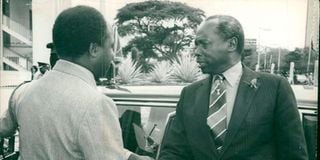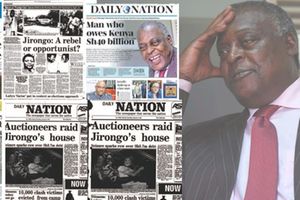Premium
Kibaki, the fence-sitter with a ruthless streak who knew when to jump in

Former President Mwai Kibaki (left) served as President Daniel Moi’s vice-president from 1978 to 1988.
As violence raged across the country following the controversial announcement by electoral commission chairman Samuel Kivuitu that President Mwai Kibaki had pipped opposition challenger Raila Odinga in the 2007 presidential elections, a late night call from State House came through to my desk at the Nation Centre.
It was Mr Isaiya Kabira, the head of the Presidential Press Service. He wanted to get a sense of the mood on the ground, and also my take on the situation. I put it to him as starkly as I could: Things were spiralling dangerously out of control. President Kibaki could do the right thing and save the country from sliding into civil war, or stick to his guns and take responsibility for destruction of Kenya.
Kabira listened politely but was non-committal, warding off my own queries on what the mood and thinking was in the President’s court. The next evening, President Kibaki was sworn-in by Chief Justice Evans Gicheru for his second term at an unusual ceremony conducted at State House with only a handful of guests. The man often dismissed as indecisive and cowardly had taken his stand.
He was widely admired as the gentleman of Kenya politics, a nice guy, but one who lacked the steel requisite of the rough and tumble. Journalist Kwendo Opanga famously described him as one who never saw a fence he did not want to sit on.
Ruthless determination
Yet behind all the negative labels lurked a ruthless determination that ultimately propelled Mwai Kibaki to the highest office in the land.
President Kibaki’s tenure was indelibly blighted by the 2007-2008 post-election violence, but that was at least part of political competition. Another negative mark was a strange and puzzling engagement with a pair of Armenian brothers that seemed to serve absolutely no purpose. It was in the middle of Kibaki’s first term that Odinga started raising the alarm about the presence of ‘mercenaries’ allegedly brought in to assassinate government foes.
He was referring to Artur Magaryan and Artur Sargasyan, jewellery-bedecked hoodlums from Armenia who had come into the country, been appointed deputy commissioners of police and given unclear assignments around training Kenyan security agencies.
Suspected drug dealers and gun-runners, they had unfettered access to sensitive security installations, courtesy of carte blanche that seemed to come from close association with President Kibaki’s long-time paramour Mary Wambui and her daughter Winne. The Armenians were bullies who loved throwing their weight around, and were believed to have been responsible for the night raid on Standard Group newsroom, the most blatant attack on Kenyan media since independence, under a president who was generally seen as a champion of democracy and media freedom.
In previous conversations, ODM leader Odinga disclosed that across the negotiation table, he often found Kibaki an even more formidable adversary than his predecessor, President Daniel arap Moi.
One could read President Moi. He laid out his thinking openly and loved nothing better than to be praised and to have his ego massaged.
President Kibaki was the exact opposite. He had no time for courtiers, and put no value on either political competitors or allies lavishing him with praise. On political negotiations, he hardly ever showed his hand, speaking little and reacting with hardly discernible grunts to everything put on the table, but leaving nobody clear on whether it was an aye or a nay.
A case in point was the negotiations ahead of the 2002 General Election leading to the formation of the National Rainbow Coalition.
Principal figures
Kibaki, Michael Kijana Wamalwa and Charity Ngilu were the principal figures in the existing National Alliance of Kenya. Across the table was a string team that had bolted from Kanu in protest at outgoing President Moi picking a political toddler, Uhuru Kenyatta, as his designated successor. They included Odinga, as well as former vice-president George Saitoti, Kalonzo Musyoka and Moody Awori.
One thing that immediately became apparent was that Mr Kibaki, already the designated presidential candidate, preferred to leave the talking to others. To some, he may have seemed distracted and out of touch, but it also spared him from having to make any specific commitments in the haggling over a power-sharing deal.
Even when an agreement was finally hammered out, there were some aspects that Kibaki firmly refused to put pen to paper. One was a commitment to serve just one term, and the other was to push for constitutional changes to make room for a prime minister from the other side. He was a gentleman, he said, and his word was his bond.
His word, as it turned out, meant for nothing once he was safely in office.
Similar tactics were seen with the talks brokered by former United Nations secretary-general Kofi Annan in the wake of the 2007-2008 post-election violence.
As the violence started to rage out of control, President Kibaki seemed to go against the spirit of any deal with his controversial swearing-in at State Hours after dark.
Negotiations after that came within the reality of a status quo where there was no vacancy in the presidency.
Then came appointment of a partial cabinet, which again seemed to shut out the opposition, but left room for inclusion in the event of any deal.
The talks that followed were hard and tough, but eventually, Annan found ways to break the stalemate by identifying key figures on either side that there amenable to reason. The strategy was to lock out apparent hard-liners such as Justice Minister Martha Karua on the government side and William Ruto on the opposition side, and have President Kibaki and Odinga meet one-on-one.
Sagana State Lodge
The president was agreeable to that and even facilitated a retreat to the Sagana State Lodge that caught most of the other participants off-guard.
A deal was quickly struck, key element being a power-sharing deal with Odinga as prime minister. Many of the figures around the president were averse to such an arrangement, but Kibaki made it clear that there was no reneging on his word and pushed through the necessary constitutional changes.
When it came to the exact powers and functions of the prime minister, however, Odinga quickly learnt that the deal was not cast in stone. He expected to assume executive power in-charge of day-to-day running of government, but once sworn-in, he found that the grey areas in the new law left him at the mercy of whatever authority the president granted him.
Early on in the job, he had to struggle to establish primacy over vice-president Kalonzo Musyoka, who had been poached from opposition ranks to bolster the government side. He was also in running battles with then Head of Public Service Francis Muthaura over his responsibilities and perks of office.
In time, however, Odinga came to earn President Kibaki’s trust, and the two formed a formidable partnership in pushing through government programmes, and most critically the campaign for a new constitution passed in 2010.
If Kibaki is today widely regarded as the best leader Kenya ever had, it was precisely because of that ability to win friends to his cause, but also to apply a ruthless determination when need be.
A story is told of how in his first term, Kibaki attended a public rally near Lenana School in Nairobi, where local MP Beth Mugo was agitating for 40 acres to be hived out for a primary school for the local community. In typical fashion, the president gave a vague assent – just that he had heard, not that he agreed. Later when Mugo, who was an assistant minister for education, tried to get the Ministry of Land to excise the targeted parcel, she found that there was no record of the president’s assent.
Land-grab
The deed establishing Lenana School is guaranteed against any excision of the land except with direct assent, by signature, of the president. The papers that landed on his desk to sanction the land-grab were ignored.
President Kibaki may at times have been overly cautious and hesitant, but he also knew when to jump in at the right time.
In the latter years of Jomo Kenyatta’s reign, the sole ruling party, Kanu, was riven by succession wars between the president’s so-called ‘Kiambu Mafia’ and the constellation around then vice-president Moi. A showdown was expected at the long awaited Kanu elections set for 1976, but it was not until then Finance Minister Kibaki jumped into the fray to run for party chairman on the Moi slate that the scales tilted decisively towards the VP.
The polls were called off at the last minute, but once Moi ascended to the presidency on Kenyatta’s death in 1978, Kibaki was a natural choice for vice-president.
In the later years of his tenure towards the 1988 elections, vice-president Kibaki came under sustained assault from the Moi forces. Across the whole of the then central province and other parts of the country where he had allies, parliamentary aspirants were sponsored to take the battle to supposedly ‘anti-Nyayo elements’. In the one-party regime, it would have been suicidal for Kibaki to fight back, and it was no surprise when many of his allies were routed in the infamously rigged queue voting Kanu nominations as a prelude to his being dropped.
As President Moi got set to form his new government, word went round that many of Kibaki’s supporters were discussing rejecting appointment if he was dropped. But it was apparent that many of them were also lobbying to be appointed in his stead.
Kibaki was dropped as VP and relegated to Minister for Health, taking up his new job uncomplainingly and with the usual competence, but throughout retaining the independent streak that had made him a marked man in the Nyayo era. He never wore the lapel badge with the Moi portrait.
Later on in the same year came the Kanu elections, which were used to weed out ‘anti-Nyayo’ elements.
In his own Othaya constituency where he had reigned unchallenged since 1974, Kibaki was reported to have lost in his local ward to some unknown villager.
“Even rigging requires some intelligence,” he burst out in a rare public display of anger. Moi backed down and the polls were repeated. When it came to the Nyeri district elections, Kibaki got his revenge by teaming up with his old foe, then Nyeri Town MP Waruru Kanja, to sweep the branch elections.
The 1988 General Election and Kanu elections swept many Moi foes out of office, but also helped create the critical mass for multi-party agitation.
When Kenneth Matiba, Charles Rubia, Oginga Odinga and others started pushing the multi-party campaign in 1990, Kibaki preferred to stand on the sidelines. He disparaged the democracy campaign with the infamous observation that ‘one cannot cut a mugumo tree with a razor blade’.
Once the campaign succeeded at the end of 1991, however, Kibaki had no qualms immediately dumping Kanu and launching his own opposition party.
Some might call it opportunism. Others will call it good timing.





